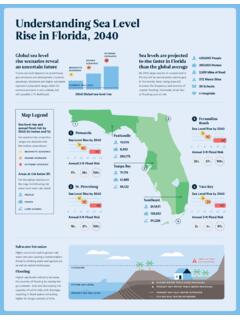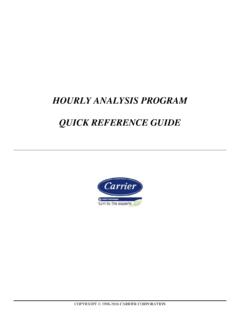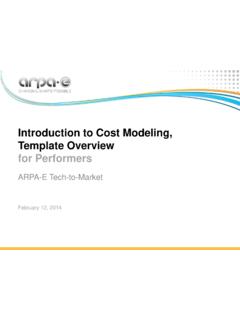Transcription of Global Energy Outlook 2021: Pathways from Paris
1 Global Energy Outlook 2021: Pathways from ParisRichard Newell, Daniel Raimi, Seth Villanueva, Brian PrestReport 21-11 June 2021 Resources for the FutureiAbout the AuthorsRichard G. Newell is president and CEO of Resources for the Future (RFF), an independent, nonprofit research institution that improves environmental, Energy , and natural resource decisions through impartial economic research and policy engagement. From 2009 to 2011, he served as the administrator of the US Energy Information Administration, the agency responsible for official US government Energy statistics and analysis. Dr. Newell is an adjunct professor at Duke University, where he was previously the Gendell Professor of Energy and Environmental Economics and founding director of its Energy Initiative and Energy Data Analytics Lab. He has also served as the senior economist for Energy and environment on the President s Councilof Economic Advisers and was previously a senior fellow and a board member at Raimi is a fellow at RFF and a lecturer at the Gerald R.
2 Ford School of Public Policy at the University of Michigan. He works on a range of Energy policy issues with a focus on tools to enable an equitable Energy transition. He has published in academic journals including Science, Science Advances, Environmental Science and Technology, Journal of Economic Perspectives, and more, and in popular outlets including The New Republic, Newsweek, Slate, and Fortune. He has presented his research for policymakers, industry and other stakeholders around the United States and internationally, including before the Energy and Mineral Resources Subcommittee of the US House s Natural Resources Committee. The Fracking Debate, his first book, combines stories from his travels to dozens of oil and gas producing regions with a detailed examination of key policy issues, and is published by Columbia University Press as part of the Columbia University Center on Global Energy Policy book series.
3 Seth Villanueva is research analyst at RFF. His current work focuses on Energy projection analysis for RFF s annual Global Energy Outlook report as well as research on the regional and distributional effects of clean Energy and climate policy. Villanueva graduated from UC Santa Barbara in 2019 with a BA in economics and a minor in mathematics. At UCSB, he was an undergraduate Gretler Fellow research assistant studying the economic impact of scaled wind power generation. Other research that Villanueva has contributed to at RFF includes a pair of value of information studies as part of the VALUABLES Consortium and Energy transition policy Prest is a fellow at Resources for the Future specializing in climate change, electricity markets, and oil and gas economics. Prest uses economic theory and econometric models to improve Energy and environmental policies by assessing their impacts on markets and pollution outcomes.
4 His recent work includes evaluating the impacts of federal tax credits for coal use. He is also working to establish an empirical basis for determining discount rates used in the social cost of carbon. His past work includes econometric analysis of the US oil and gas industry, understanding the economic effects of rising temperatures, modeling the market dynamics of climate change policy under policy uncertainty, and assessing household responses to timevarying electricity pricing. His work has appeared in the Journal of the Association of Environmental and Resource Economists, Energy Economics, and The Energy Energy Outlook 2021: Pathways from ParisiiAcknowledgements We thank Stu Iler, who initially developed the platform for harmonizing outlooks. We also thank those who assisted by providing data and context, including Matthias Kimmel and Seb Henbest at BloombergNEF; Christof van Agt at the International Energy Forum; Will Zimmern at BP; Tord Bj rndal at Equinor; Filip Schittecatte at ExxonMobil; Tim Gould, Laura Cozzi, and Pawel Olejarnik at IEA; Dolph Geilen, Prakash Gayarthi, Francesco La Camera, and Nicholas Wagner at IRENA; and Julius Walker at OPEC.
5 We would also like to thank Massimo Tavoni of the RFF-CMCC European Institute on Economics and the Environment for assistance in incorporating scenarios from the IPCC process. We also thank Zeke Hausfather of the Breakthrough Institute and Julio Friedmann of Columbia University s Center on Global Energy Policy for help with technical questions related to carbon budgets and carbon capture. Photos: Simeonn / Shutterstock (cover); Marek Piwnicki / (page 14); Matthew Henry / (page 19); Andreas G cklhorn / (page 22).About RFF Resources for the Future (RFF) is an independent, nonprofit research institution in Washington, DC. Its mission is to improve environmental, Energy , and natural resource decisions through impartial economic research and policy engagement. RFF is committed to being the most widely trusted source of research insights and policy solutions leading to a healthy environment and a thriving economy.
6 The views expressed here are those of the individual authors and may differ from those of other RFF experts, its officers, or its Our WorkOur work is available for sharing and adaptation under an Attribution International (CC BY ) license. You can copy and redistribute our material in any medium or format and remix, transform, and build upon the material for any purpose, even commercially. You must give appropriate credit, provide a link to the license, and indicate if changes were made. You may do so in any reasonable manner, but not in any way that suggests the licensor endorses you or your use. For more information, visit for the FutureiiiAbstractAs parts of the world begin to recover from the COVID-19 pandemic, a fundamental shift in the Global Energy system is needed to avoid the worst impacts of climate change. Despite efforts by policymakers in some nations to stimulate a green recovery, far greater effort will be required to spur the scale and speed of technological change necessary to limit warming to or 2 Celsius by 2100.
7 In this annual report, we review and compare on an apples-to-apples basis recent long-term projections from some of the world s leading Energy institutions. These projections range widely from those that assume little to no change in Energy and climate policies to those that lay out technological feasible yet politically challenging Pathways to limit climate change, improve Energy access, and reduce air pollution. This year s report provides particular insight into the differences between Pathways aligned with the and 2 Celsius climate targets; the effects of COVID-19 on future population, GDP, and Energy demand; and the Energy intensity of the Global Energy Outlook 2021: Pathways from ParisivContents1. Introduction 12. Key findings 33. In focus Paris : What s in a name? The IPCC s Illustrative Pathways to C Comparing C and 2 C scenarios The role of large-scale CCS Global population and economic growth post-COVID Energy intensity: historical trends and future Pathways 204.
8 Data and methods Harmonization 245. Statistics 266. References 39 Resources for the Future11. IntroductionLong-term Energy projections vary widely, depending on underlying assumptions and methodologies. This report provides a unique apples-to-apples comparison of projections and addresses the full scope of potential changes to the Energy system as envisioned by some of its most knowledgeable organizations. Table 1 shows the historical datasets, outlooks, and scenarios. Table 1. Outlooks and scenarios examined in this reportSourceDataset or OutlookScenario(s)Ye a r sGrubler (2008)Historical 1800 1970 IEA (2018)Historical 1970 2015 IEA (2021)Historical 2020 BloombergNEF (2020)New Energy Outlook 2020 Economic Transition ScenarioTo 2050BP (2020) Energy Outlook 2020 Business as Usual (BAU), Rapid Transition (RT), Net Zero (NZ)To 2040 Equinor (2020) Energy Perspectives 2020 Reform, Renewal, RivalryTo 2050 IEA (2020)World Energy Outlook 2020 Stated Policies (STEPS), Sustainable Development (SDS)To 2040 IPCC (Rogelj et al.)
9 2018)Special Report on CIllustrative Pathways 1 4 (IP1, IP2, IP3, IP4)To 2100 IRENA (2020) Global Renewables OutlookPlanned Energy Scenario, Transforming Energy ScenarioTo 2050 OPEC (2020)World Oil Outlook 2020 ReferenceTo 2045A brief description of our methodology is provided under Data and Methods (Section 4), with select data indicators under Statistics (Section 5). For the full methodology, data set, and interactive graphing tools, visit We include 2020 Energy demand and emissions figures based on estimates provided in the IEA s Global Energy Review 2021. However, most of our analysis compares future Energy and emissions levels with those seen in 2019, which we choose as a baseline because it was relatively unaffected by the COVID-19 pandemic. Global Energy Outlook 2021: Pathways from Paris2We use a consistent labeling system that distinguishes among the different scenarios (see Table 2): For Reference scenarios, which assume limited or no new policies, and for Equinor s Rivalry scenario, which assumes continued geopolitical challenges, we use a long-dashed line: this set comprises Equinor s Rivalry, IRENA s Planned Energy Scenario, and OPEC s Reference.
10 For Evolving Policies scenarios, which assume that policies and technologies develop according to recent trends and/or the expert views of the team producing the Outlook , we use solid lines: this set comprises BNEF, BP BAU, Equinor Reform, and IEA STEPS. For Ambitious Climate scenarios, which are built around limiting Global mean temperature rise to 2 C by 2100, we use short-dashed lines: this set comprises BP s Rapid Transition, Equinor s Rebalance, IEA s SDS, and IRENA s Transforming Energy Scenario. Finally, we include an additional set of Ambitious Climate scenarios designed to limit Global mean temperature rise to C by 2100, which we illustrate with a dotted line: BP s Net Zero and the four Illustrative Pathways (IPs) published in the IPCC s 2018 Special Report on C. For additional detail on scenarios, see Table 5. Table 2. Legend for Different Scenario TypesReferenceEvolving PoliciesAmbitious Climate (2 C)Ambitious Climate ( C) Equinor Rivalry BNEF BP Rapid Transition BP Net Zero IRENA Planned BP BAU Equinor Rebalance IPCC IP1 OPEC Equinor Reform IEA SDS IPCC IP2 IEA STEPS IRENA Transforming IPCC IP3 IPCC IP4 Figures and tables in this report frequently refer to regional groupings of East and West.








